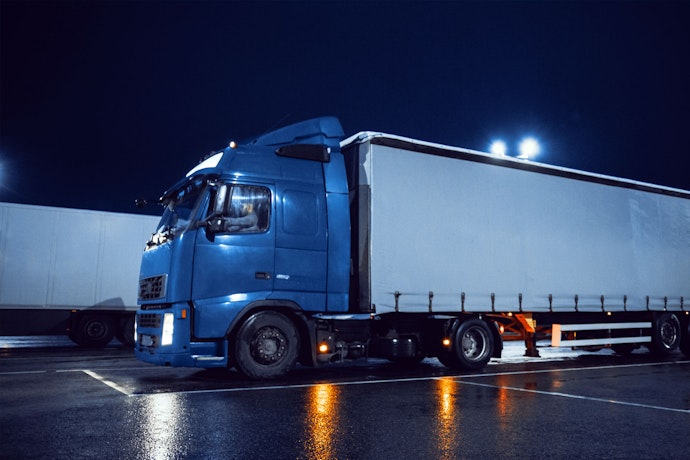Digital tachograph cards guide
Digital tachograph cards are crucial for regulatory compliance and monitoring driver hours. But how do they work? Verizon...
Read more
The first generation of smart tachographs has been mandatory in all new heavy-duty vehicles since June 2019. Now, the European Union is raising the bar on safety and introducing new tachograph regulations, which will require second-generation tachographs to be installed from August 2023 and will have implications for the UK HGV vehicles on EU roads.
The tachograph is the device responsible for recording various aspects of a driver's work, including driving times, rest periods and periods of other work and availability. By preventing driver fatigue and ensuring fair competition, the tachograph ultimately serves to promote road safety (1).
Further to this, driver fatigue in the UK is a factor in 20% of all road crashes (2). Diving into this topic, ROSPA stated that these types of crashes are about 50% more likely to result in death or serious injury as they tend to be high speed impacts because a driver who has fallen asleep cannot brake or swerve to avoid or reduce the impact.
Unfortunately, fatigued driving is relatively common among (international) HGV drivers, people working (night) shifts, young men and people with untreated sleep problems/disorders. Taxi drivers are also seen as a risk group for fatigued driving’ (3).
Safety is therefore the main reason why the new tachographs rules state that installing a tachograph is mandatory in new vehicles weighing more than 3. 5 tonnes when they are intended for the transport of goods, new vehicles carrying more than 9 persons including the driver, or when they are intended for the transport of passengers (4).
Currently, there is a regulation in force governing the use of the tachograph: Regulation (EU) No. 165/2014 which lays the foundations for this security system. Since June 2019, a new generation of digital tachographs, (known as smart tachographs), has been installed in newly registered HGVs and buses (5).
Under the new EU tachograph regulation, No. 165/2014, an updated version of the smart tachograph – version 2 – is set to be launched in 2023. This new device not only records a driver's activity but also boasts additional functionalities geared towards enforcing EU legislation on cabotage and posting of workers. These features include the ability to record border crossings and detect the precise location of a vehicle during load/unload operations (7).
The new smart tachograph version 2 is set to enhance the anti-tampering resistance of its predecessor. This will be achieved through a range of innovative features, such as the ability to authenticate satellite signals and the installation of an internal sensor that operates independently from the external motion sensor (8).
There are several important dates for the implementation of the smart tachograph version 2 or second-generation smart tachograph (9):
August 2023
According to the new tachograph rules, the second generation of smart tachographs must be installed in all new registered vehicles with a permissible weight of 3.5 tonnes or more by the 31st of August.
December 2024
From December 31st, 2024, all international road transport vehicles weighing 3.5 tonnes or more must switch to the latest smart tachograph version 2 for improved tracking and safer roads. This also includes vehicles equipped with an analogue or digital non-smart tachograph.
August 2025
By the 18th of August 2025 the vehicles equipped with a smart tachograph version 1 will need to replace and install the second generation of this smart technology.
July 2026
By the 1st of July, all new vehicles above 2.5 tonnes in international road transport or cabotage operations will be equipped with a smart tachograph version 2 (second generation smart tachograph).
Fleet managers bear the responsibility of ensuring that their drivers comply with the new EU tachograph regulations, safeguarding the legal obligations of the company and its owners. Failure to comply can result in significant legal and financial penalties.
Integrating a digital tachograph with a smart and easy-to-use GPS tracking solution allows fleet managers to access the tachographs status in near real-time. This gives them visibility of their fleets, drivers and their schedules globally. Allowing for better planning, decision making and higher productivity whilst ensuring compliance.
Fleet managers can leverage automated tachograph file downloads to ensure compliance with mandatory driver tachograph card and tachograph file archiving requirements without disrupting their drivers' schedules. This approach allows for seamless tracking of drivers and vehicles, while also providing a central repository for all downloaded files. This makes it easy to access files for audits or analysis.
To learn more about the benefits of bundling the digital tachograph and a fleet management solution schedule a demo today.
Find out how our platform gives you the visibility you need to get more done.
Sources UK:
(2)Source: https://eur-lex.europa.eu/legal-content/EN/TXT/HTML/?uri=PI_COM:C(2021)2639&from=EN )
(4) https://eur-lex.europa.eu/EN/legal-content/summary/tachographs-in-road-transport.html
(5) https://eur-lex.europa.eu/EN/legal-content/summary/tachographs-in-road-transport.html
(6-7-8-9)https://www.gov.uk/tachographs and https://eur-lex.europa.eu/EN/legal-content/summary/tachographs-in-road-transport.html
Tags: Compliance



Find out how our platform gives you the visibility you need to get more done.
Digital tachograph cards are crucial for regulatory compliance and monitoring driver hours. But how do they work? Verizon...
Read moreFleet managers face many daily challenges. Find out how GPS vehicle tracking can help boost performance and make your...
Read moreThe most common infringements include driver hours offences, tachograph infringements and technical offences. Learn more...
Read moreCOVID-19 was a big challenge last year. The digitalisation of businesses has become critical in order for them to remain...
Read more